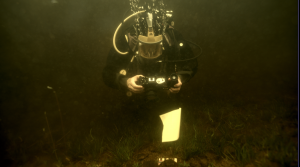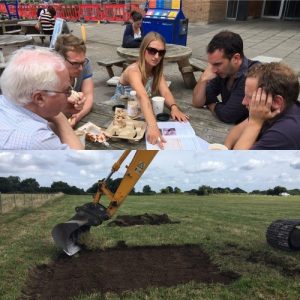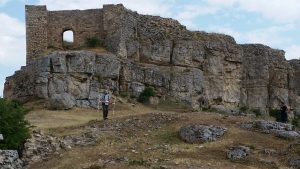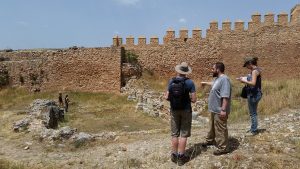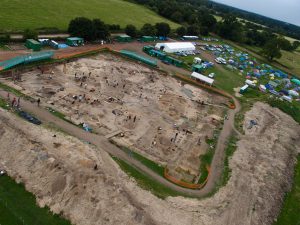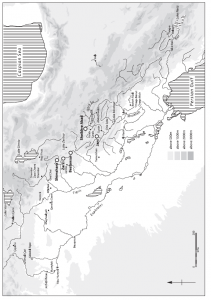Gdańsk (Monday 6th June 2016, Alex Miller)
 After waking up far too early and sparing way too much time to get to the airport, we were finally in the air and flying over northern Europe. It was a beautiful day and the plane journey took us about 2 hours. As we neared the end and were clearly flying over northern Poland the things that struck me were the vast dark green forests that covered significant portions of the countryside, the many lakes and the small isolated farmsteads. On landing we took a bus through the outskirts of Gdańsk which were littered with Soviet era buildings to the old town where we were staying for the night. We spent the afternoon and evening wondering around the old town. It was surprising to learn (as I am shamefully quite ignorant of modern history) that the majority of the old town had been destroyed by the Red Army at the end of the Second World War and that much of what I was seeing was in fact far newer than I had thought, though it had been reconstructed in the old Hanseatic style. This was both sad, to learn of the destruction, and refreshing to see that it had been rebuilt so well in its original style. The buildings that we saw included warehouses, churches, shops and houses. The houses and shops were particularly beautiful, as they were all painted in different colours and often had friezes detailing particular events in the town’s history, certain merchants or goods that were being sold. Seeing the old town was important because not only did it get me thinking about medieval town layouts and life there in the medieval period, but perhaps more importantly it impressed on me how relevant medieval history still is in Gdańsk, and that they recognise it as part of their heritage, enough to rebuild it in the old style out of the rubble.
After waking up far too early and sparing way too much time to get to the airport, we were finally in the air and flying over northern Europe. It was a beautiful day and the plane journey took us about 2 hours. As we neared the end and were clearly flying over northern Poland the things that struck me were the vast dark green forests that covered significant portions of the countryside, the many lakes and the small isolated farmsteads. On landing we took a bus through the outskirts of Gdańsk which were littered with Soviet era buildings to the old town where we were staying for the night. We spent the afternoon and evening wondering around the old town. It was surprising to learn (as I am shamefully quite ignorant of modern history) that the majority of the old town had been destroyed by the Red Army at the end of the Second World War and that much of what I was seeing was in fact far newer than I had thought, though it had been reconstructed in the old Hanseatic style. This was both sad, to learn of the destruction, and refreshing to see that it had been rebuilt so well in its original style. The buildings that we saw included warehouses, churches, shops and houses. The houses and shops were particularly beautiful, as they were all painted in different colours and often had friezes detailing particular events in the town’s history, certain merchants or goods that were being sold. Seeing the old town was important because not only did it get me thinking about medieval town layouts and life there in the medieval period, but perhaps more importantly it impressed on me how relevant medieval history still is in Gdańsk, and that they recognise it as part of their heritage, enough to rebuild it in the old style out of the rubble.
Malbork (7th June 2016, Jess Barnsley)
Our first full day in Poland started with a train journey. The train to Malbork took us through some beautiful stretches of rural Poland, and it was a pleasure to see the expanses of greenery and forests from the windows of northern Poland’s new “high speed” trains.
The town of Malbork was as expected, a “soviet style” town with rows of grey, characterless block flats and gridded streets- an unfortunate result of the devastation Poland (then Eastern Prussia) faced during WW2 and the years following.
 The ‘bleakness’ of the town was a dramatic contrast to the sight we beheld as we rounded the corner to Malbork’s outer walls and moat. The castle is spectacular. Breathtaking in its sheer size and construction, with the statue of the Virgin Mary proudly reconstructed, the glass mosaic dazzling in the sun.
The ‘bleakness’ of the town was a dramatic contrast to the sight we beheld as we rounded the corner to Malbork’s outer walls and moat. The castle is spectacular. Breathtaking in its sheer size and construction, with the statue of the Virgin Mary proudly reconstructed, the glass mosaic dazzling in the sun.
After quickly unpacking our belongings in the cosy apartments which would be home for the next two days, we met with Zbigniew Sawicki the head of the archaeology department based at Malbork castle. We had a chance to handle some of the castles artefacts; delicate locks and keys, largely intact pottery vessels all the way through to a huge swords found discarded in the moat of the castle.
The castle precinct is vast, and the walk is long, but the views of the castle from the river side were truly spectacular. We were blessed with clear skies and scorching sun, which allowed panoramic views from the tower (well worth the agonizing climb). I couldn’t help but wonder to myself how phenomenal an experience this tower would have been to the men who constructed and worked on it. To see the world from a perspective no other person they knew had reached, in a time before flight, in an area void of mountains, to stand atop this tower would surely have been a life changing experience.
The interior of the castle met with the exterior’s grandeur. The team at Malbork have met the difficult task of preserving and presenting the castle marvellously. There is no way to summarise all of the wonderful features of the castle in just a few words, it really is a sight to behold. The tiled floors, painted arches, vaulted ceilings and not forgetting galleries filled with more amber than one person could need to see in one lifetime are second to none!
Though the day was long and tiring, our time at Malbork castle was far too short. One could spend days roaming the halls and galleries of the building and examining the brickwork fabric of the walls (a habit we had all developed by the time we left Poland!). It is truly one of the greatest medieval sites in the world.
Kwidzyn and Gniew (8th June 2016, Rob Backhouse)
An early morning departure from Malbork saw us taking the train to Kwidzyn, about 25 miles to the south, following the eastern edge of the Forest of Sztum along the escarpment above the Vistula floodplain. We were here to see the unusual conjoined castle and cathedral of Marienwerder, which contained one of the burial sites of the Grand Masters of the Teutonic Order. Our animated local guide showed us a display of three recently discovered burials, taking particular pleasure in the fact that the corresponding crypt at Malbork had produced no extant remains. He was also keen that we see what he called “the largest brick toilet in the world”, which was in fact the latrine tower of the castle and is probably the most striking surviving example of this particular feature of Teutonic Order architecture. The interior of the castle contained an extremely eclectic museum covering everything from modern art to natural history, via a corridor that could have come straight from the Museum of English Rural Life in Reading.
After a quick lunch we made the short trip to the small town of Gniew, with its imposing castle and church dominating the view from the south along the Vistula. From the outside, Mewe Castle is a classic example of the conventual style followed by the Teutonic Order in the late-13th and 14th centuries. Inside, much of the space was given over to a series of displays catering for the large number of visiting school groups (including a dungeon full of the most fiendish torture implements the 19th century mind could imagine), while the sound of children cheering as a 16th century Polish Hussar obliterated watermelons in a variety of creative ways in the grounds outside provided a constant backdrop to our visit. We had seen the continuing resonance of this period of medieval history as we made our way through Gniew’s quaint Old Town earlier in the day, where a modern monument incorporates imagery from the defeat of the Teutonic Order by the Polish-Lithuanian alliance at the Battle of Grunwald in 1410.
A sudden thunderstorm heralded the end of our visit and provided the only break in the otherwise glorious weather we enjoyed during the trip, and we were glad to be able to call a taxi to collect us as the roads back to Kwidzyn began to flood at an alarming rate.
Travelling home (9th June 2016, Alex Pope)
The last day in Poland was devoted to travelling. We caught the train west from Malbork to Gdańsk and, following the compulsory period of English tourist confusion over public transport in another language, we eventually made our way to Lech Wałęsa airport, where we had started our journey three days previously.
I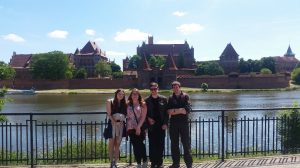 t was a wonderful fieldtrip, and we all really valued the opportunity to explore and examine the medieval sites of Poland. They brought our Baltic Crusades module to life, and immeasurably increased our understanding and learning.
t was a wonderful fieldtrip, and we all really valued the opportunity to explore and examine the medieval sites of Poland. They brought our Baltic Crusades module to life, and immeasurably increased our understanding and learning.
We had an amazing, if occasionally bizarre, time. We visited some fascinating sites, interacted with some brilliant archaeologists, enjoyed beautiful weather and, as is obligatory for travelling archaeologists, sampled the local Polish culture.
Many thanks to Dr Aleks Pluskowski for organising the fieldtrip, and to all the Polish archaeologists and guides who showed us the sites and helped us to understand them. Thanks in particular must go to Zbigniew Sawicki, along with Waldemar Jaszczyński, who took the time to show us the finds from Malbork and gave us an incredible tour of the castle.
 The Current Archaeology Awards 2017 are open for voting, and for the third year in a row we have a contender in the ‘Archaeologist of the Year’ category – our Emeritus Professor, Richard Bradley!
The Current Archaeology Awards 2017 are open for voting, and for the third year in a row we have a contender in the ‘Archaeologist of the Year’ category – our Emeritus Professor, Richard Bradley!

